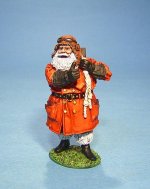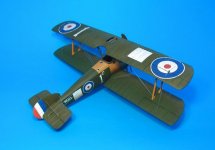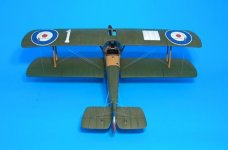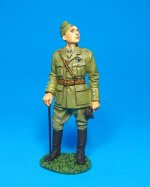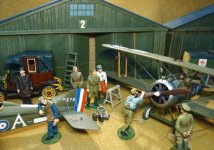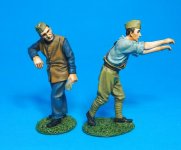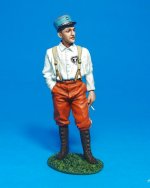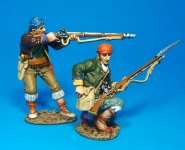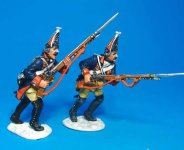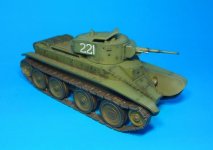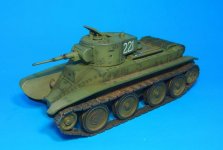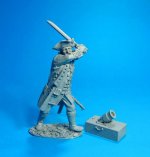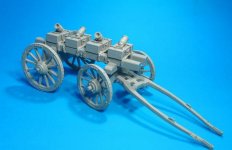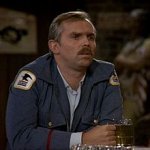Good Morning from the San Francisco Bay Area, where you will be all glad to know it is raining. For us this is exciting as it is the first rain in 6 months. For those off to the Military History Weekend in Virginia, I look forward to seeing you there.
Well we have some terrific releases for November, that will make great Christmas presents, hint! We hopefully this year will have Santa, plus the first of the WWI hangers and of course Club sets. On these we cheated by making them British and bringing out two of them. If you like them, please pre-order soon.
As always hope you like the new releases as much as I do, we will have them listed on the web site this morning.
www.sierratoysoldier.com
We are still working on a couple of images, so please watch for a mini update a little later on.
Best regards
Mike
Sierra Toy Soldier Company
KNIGHTS OF THE SKIES
Hopefully… I was nicer this year, and the Santa figure will be available in time for this Christmas!
ACE-X - BARON VON SANTA, “CHOCS AWAY!”
(1pcs)
Retail us$39
Of the 5,734 Sopwith Camels delivered (5,914 were ordered), none is more famous than that flown by the Canadian ace, William George Barker - B6313.
B6313 was completed by the Sopwith Aviation Co. Ltd of Kingston-on-Thames and delivered to the Aeroplane Acceptance Park at Kenley on 11 September 1917. On the 24th September B6313 went to No.28 Sqn RFC based at Yatesbury.
No.28 Sqn was getting ready to go to France and on 2 October a new 'C' Flight commander joined the squadron. William George Barker and B6313 were to be together for the next year.
On 8 October 1917, No.28 Sqn flew to France, and later that same day Barker shot down an Albatros D.V ,which he didn't claim as he wasn't supposed to cross the lines. The squadron officially began operations on 18 October, and Barker claimed a green Albatros D.III shot down on 20 October. By the end of the month he had scored two more times, when No.28 Sqn. was notified that it was to be transferred to the Italian front.
At this time B6313 carried the No.28 Sqn RFC's marking of a white square on the fuselage and upper wing. Additionally each aircraft carried an identifying number and flight letter.
ACE-14 - SOPWITH CAMEL B6313 No.28 Sqn, RFC, October 1917
(1pcs)
Retail us$188
William George Barker VC, DSO & Bar, MC & Two Bars (3 November 1894 – 12 March 1930) was a Canadian First World War fighter ace and Victoria Cross recipient. He is the most decorated serviceman in the history of Canada, and indeed in the history of the British Empire and Commonwealth of Nations.
ACE-14P - CAPTAIN William G. Barker, VC,DSO & Bar, MC & Two Bars.
3 November 1894 – 12 March 1930.
(1pcs)
Retail us$36
Barker returned to Canada in May 1919 as the most decorated Canadian of the war, with the Victoria Cross, the Distinguished Service Order and Bar, the Military Cross and two Bars, two Italian Silver Medals for Military Valour, and the French Croix de guerre. He was also mentioned in despatches three times. The Canadian Daily Record, a publication of the Overseas Military Forces of Canada, wrote in December 1918 that William Barker of Dauphin, Manitoba was the Canadian holding the record for "most fighting decorations" in the war. No other Canadian soldier, sailor or airman has surpassed this record, and the Canadian War Museum exhibit, located in Ottawa, Ontario, states: "Lieutenant Colonel William G. Barker, one of the legendary aces of the war, remains the most decorated Canadian in military service." A plaque on his tomb in the mausoleum of Toronto's Mount Pleasant Cemetery, officially unveiled on September 22, 2011, describes him as "The most decorated war hero in the history of Canada, the British Empire, and the Commonwealth of Nations." Only two other servicemen in the history of the Commonwealth or Empire have received as many British medals for gallantry. These were Mick Mannock and James McCudden, and like Barker, both were "scout pilots" in the First World War. Barker, Mannock and McCudden each received six British medals, including the Victoria Cross. McCudden was also awarded a French Croix de Guerre. But with his three foreign medals and three British Mentions in Despatches, Barker received a total of 12 awards for valour.
ALLIED GROUNDCREW AND ACCESSORIES
There will be 5 figures not including the pilot, which will make up the “starter Set”.
BGC-06 - “Chocs Away!” Starter set,
(2pcs)
Retail us$68
*PLEASE NOTE THE BRITISH HANGER WILL BE AVAILABLE IN EARLY 2013*
Charles Eugène Jules Marie Nungesser, MC (15 March 1892 – presumably on or after 8 May 1927) was a French ace pilot and adventurer, best remembered as a rival of Charles Lindbergh. Nungesser was a renowned ace in France, rating third highest in the country for air combat victories during World War I.
Famed for his injuries, as well as his overall score of 43 victories, it was said that he had broken every major bone in his body at least once!
He was also well known for his macabre personal insignia, which was a white- edged black heart, on to which he had painted a coffin, two candle sticks and a skull and crossbones. He even went as far as to have a simular badge sewn on to his shirt pocket.
ACE-12P - Lieutenant Charles Nungesser,
(1pcs)
Retail us$36
GERMAN GROUNDCREW AND ACCESSORIES
The first of several buildings and accessories for both the allied and German airfields. This set comes with 3 separate numbers for the building so that multiple hangers may be used together.
GGC-10 - German Hanger,
(5pcs)
Retail us$118
Model Size 14 ½” x 2 ¼” x 7 ½”
Note Picture to follow.
THE PENINSULAR WAR 1807-1814
PSG-03 - SPANISH GUERILLAS
Loading and Firing #2
(2pcs)
Retail us$78
THE SEVEN YEARS WAR
LEUT-06 - THE BATTLE OF LEUTHEN 1757 ARMY OF FREDERICK THE GREAT
PRUSSIAN GRENADIERS ADVANCING#4
2 Figures (2pcs)
Retail us$76
THE FIRST SUDAN WAR 1884-1885
MADCAV-02 - BAQQARA LANCER AND WOUNDED HORSE,
(2pcs)
Retail us$82
THE SECOND WORLD WAR
The BT tanks were a series of Soviet cavalry tanks produced in large numbers between 1932 and 1941. They were lightly armoured, but reasonably well-armed for their time, and had the best mobility of all contemporary tanks of the world. The BT tanks were known by the nickname Betka .
They first saw action in the Spanish Civil War. A battalion of BT-5s fought on the Republican side, and their 45 mm guns could easily knock out the opposing German and Italian light tanks.
The BT tanks were "convertible tanks". This was a feature designed by J. Walter Christie to reduce wear of the unreliable tank tracks of the 1930s. In about thirty minutes the crew could remove the tracks and engage a chain drive to the rearmost road wheel on each side, allowing the tank to travel at very high speeds on roads. In wheeled mode the tank was steered by pivoting the front road wheels. However, Soviet tank forces soon found the convertible option of little practical use in a country with few paved roads, and it consumed space and added needless complexity and weight. The feature was dropped from later Soviet designs.
The direct successor of the BT tanks would be the famous T-34 medium tank, introduced in 1940.
SOV-01 BT-5, “Fast Tank”,
(2pcs)
Retail us$178
JJ DESIGNS COLLECTORS’ CLUB SET#12
STATUS –PREVIEW PERIOD, 12th OCTOBER- 31st OCTOBER 2012
**Please note the terms and conditions for the collectors club special sets has not changed**
Buchanan was a lieutenant in the Royal Artillery. He was wounded at the Battle of the Monongahela. He was later to be promoted to captain in 1759.
JJCLUBSET-12 Battle On The Monongahela 1755
Lieutenant Francis James Buchanan, and Light Coehorn Mortar,
(2pcs)
Limited Edition (TBA)
Retail us$43
Note Picture to follow.
It has been noted that there were over 500 pack horses with Braddock’s army.
The train of artillery consisted of, six brass 6pdr cannons, four brass 12 pdr cannons, four 8 inch brass howitzers, and fifteen, 4 2/5in brass Coehorn mortars.
These light Coehorn mortars could have been transported on flat truck carriages.
This model is based on the reproduction at Fort Ligonier Museum.
http://fortligonier.org
JJCLUBSET-14 Battle On The Monongahela 1755
Mortar Wagon,
(5pcs)
Limited Edition (TBA)
Retail us$75
PLEASE NOTE BAL-03 WILL BE NEEDED AS HORSES FOR THIS WAGON.
Note Picture to follow.
Hope you like the new releases as much as I do. Will update as soon as I can with the latest images.
Best regards
Mike
Sierra Toy Soldier Company
Well we have some terrific releases for November, that will make great Christmas presents, hint! We hopefully this year will have Santa, plus the first of the WWI hangers and of course Club sets. On these we cheated by making them British and bringing out two of them. If you like them, please pre-order soon.
As always hope you like the new releases as much as I do, we will have them listed on the web site this morning.
www.sierratoysoldier.com
We are still working on a couple of images, so please watch for a mini update a little later on.
Best regards
Mike
Sierra Toy Soldier Company
KNIGHTS OF THE SKIES
Hopefully… I was nicer this year, and the Santa figure will be available in time for this Christmas!
ACE-X - BARON VON SANTA, “CHOCS AWAY!”
(1pcs)
Retail us$39
Of the 5,734 Sopwith Camels delivered (5,914 were ordered), none is more famous than that flown by the Canadian ace, William George Barker - B6313.
B6313 was completed by the Sopwith Aviation Co. Ltd of Kingston-on-Thames and delivered to the Aeroplane Acceptance Park at Kenley on 11 September 1917. On the 24th September B6313 went to No.28 Sqn RFC based at Yatesbury.
No.28 Sqn was getting ready to go to France and on 2 October a new 'C' Flight commander joined the squadron. William George Barker and B6313 were to be together for the next year.
On 8 October 1917, No.28 Sqn flew to France, and later that same day Barker shot down an Albatros D.V ,which he didn't claim as he wasn't supposed to cross the lines. The squadron officially began operations on 18 October, and Barker claimed a green Albatros D.III shot down on 20 October. By the end of the month he had scored two more times, when No.28 Sqn. was notified that it was to be transferred to the Italian front.
At this time B6313 carried the No.28 Sqn RFC's marking of a white square on the fuselage and upper wing. Additionally each aircraft carried an identifying number and flight letter.
ACE-14 - SOPWITH CAMEL B6313 No.28 Sqn, RFC, October 1917
(1pcs)
Retail us$188
William George Barker VC, DSO & Bar, MC & Two Bars (3 November 1894 – 12 March 1930) was a Canadian First World War fighter ace and Victoria Cross recipient. He is the most decorated serviceman in the history of Canada, and indeed in the history of the British Empire and Commonwealth of Nations.
ACE-14P - CAPTAIN William G. Barker, VC,DSO & Bar, MC & Two Bars.
3 November 1894 – 12 March 1930.
(1pcs)
Retail us$36
Barker returned to Canada in May 1919 as the most decorated Canadian of the war, with the Victoria Cross, the Distinguished Service Order and Bar, the Military Cross and two Bars, two Italian Silver Medals for Military Valour, and the French Croix de guerre. He was also mentioned in despatches three times. The Canadian Daily Record, a publication of the Overseas Military Forces of Canada, wrote in December 1918 that William Barker of Dauphin, Manitoba was the Canadian holding the record for "most fighting decorations" in the war. No other Canadian soldier, sailor or airman has surpassed this record, and the Canadian War Museum exhibit, located in Ottawa, Ontario, states: "Lieutenant Colonel William G. Barker, one of the legendary aces of the war, remains the most decorated Canadian in military service." A plaque on his tomb in the mausoleum of Toronto's Mount Pleasant Cemetery, officially unveiled on September 22, 2011, describes him as "The most decorated war hero in the history of Canada, the British Empire, and the Commonwealth of Nations." Only two other servicemen in the history of the Commonwealth or Empire have received as many British medals for gallantry. These were Mick Mannock and James McCudden, and like Barker, both were "scout pilots" in the First World War. Barker, Mannock and McCudden each received six British medals, including the Victoria Cross. McCudden was also awarded a French Croix de Guerre. But with his three foreign medals and three British Mentions in Despatches, Barker received a total of 12 awards for valour.
ALLIED GROUNDCREW AND ACCESSORIES
There will be 5 figures not including the pilot, which will make up the “starter Set”.
BGC-06 - “Chocs Away!” Starter set,
(2pcs)
Retail us$68
*PLEASE NOTE THE BRITISH HANGER WILL BE AVAILABLE IN EARLY 2013*
Charles Eugène Jules Marie Nungesser, MC (15 March 1892 – presumably on or after 8 May 1927) was a French ace pilot and adventurer, best remembered as a rival of Charles Lindbergh. Nungesser was a renowned ace in France, rating third highest in the country for air combat victories during World War I.
Famed for his injuries, as well as his overall score of 43 victories, it was said that he had broken every major bone in his body at least once!
He was also well known for his macabre personal insignia, which was a white- edged black heart, on to which he had painted a coffin, two candle sticks and a skull and crossbones. He even went as far as to have a simular badge sewn on to his shirt pocket.
ACE-12P - Lieutenant Charles Nungesser,
(1pcs)
Retail us$36
GERMAN GROUNDCREW AND ACCESSORIES
The first of several buildings and accessories for both the allied and German airfields. This set comes with 3 separate numbers for the building so that multiple hangers may be used together.
GGC-10 - German Hanger,
(5pcs)
Retail us$118
Model Size 14 ½” x 2 ¼” x 7 ½”
Note Picture to follow.
THE PENINSULAR WAR 1807-1814
PSG-03 - SPANISH GUERILLAS
Loading and Firing #2
(2pcs)
Retail us$78
THE SEVEN YEARS WAR
LEUT-06 - THE BATTLE OF LEUTHEN 1757 ARMY OF FREDERICK THE GREAT
PRUSSIAN GRENADIERS ADVANCING#4
2 Figures (2pcs)
Retail us$76
THE FIRST SUDAN WAR 1884-1885
MADCAV-02 - BAQQARA LANCER AND WOUNDED HORSE,
(2pcs)
Retail us$82
THE SECOND WORLD WAR
The BT tanks were a series of Soviet cavalry tanks produced in large numbers between 1932 and 1941. They were lightly armoured, but reasonably well-armed for their time, and had the best mobility of all contemporary tanks of the world. The BT tanks were known by the nickname Betka .
They first saw action in the Spanish Civil War. A battalion of BT-5s fought on the Republican side, and their 45 mm guns could easily knock out the opposing German and Italian light tanks.
The BT tanks were "convertible tanks". This was a feature designed by J. Walter Christie to reduce wear of the unreliable tank tracks of the 1930s. In about thirty minutes the crew could remove the tracks and engage a chain drive to the rearmost road wheel on each side, allowing the tank to travel at very high speeds on roads. In wheeled mode the tank was steered by pivoting the front road wheels. However, Soviet tank forces soon found the convertible option of little practical use in a country with few paved roads, and it consumed space and added needless complexity and weight. The feature was dropped from later Soviet designs.
The direct successor of the BT tanks would be the famous T-34 medium tank, introduced in 1940.
SOV-01 BT-5, “Fast Tank”,
(2pcs)
Retail us$178
JJ DESIGNS COLLECTORS’ CLUB SET#12
STATUS –PREVIEW PERIOD, 12th OCTOBER- 31st OCTOBER 2012
**Please note the terms and conditions for the collectors club special sets has not changed**
Buchanan was a lieutenant in the Royal Artillery. He was wounded at the Battle of the Monongahela. He was later to be promoted to captain in 1759.
JJCLUBSET-12 Battle On The Monongahela 1755
Lieutenant Francis James Buchanan, and Light Coehorn Mortar,
(2pcs)
Limited Edition (TBA)
Retail us$43
Note Picture to follow.
It has been noted that there were over 500 pack horses with Braddock’s army.
The train of artillery consisted of, six brass 6pdr cannons, four brass 12 pdr cannons, four 8 inch brass howitzers, and fifteen, 4 2/5in brass Coehorn mortars.
These light Coehorn mortars could have been transported on flat truck carriages.
This model is based on the reproduction at Fort Ligonier Museum.
http://fortligonier.org
JJCLUBSET-14 Battle On The Monongahela 1755
Mortar Wagon,
(5pcs)
Limited Edition (TBA)
Retail us$75
PLEASE NOTE BAL-03 WILL BE NEEDED AS HORSES FOR THIS WAGON.
Note Picture to follow.
Hope you like the new releases as much as I do. Will update as soon as I can with the latest images.
Best regards
Mike
Sierra Toy Soldier Company
Attachments
Last edited:


